Welcome to the Ford Motor Company Pavilion
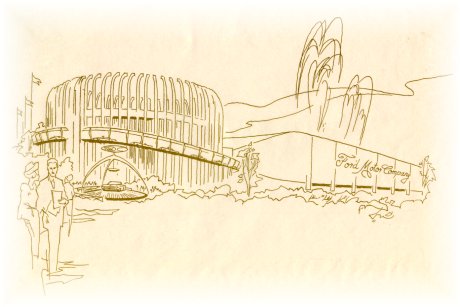
|
Ford Motor Company is happy to welcome you as its honored guest at the Ford Pavilion of the 1964-1965 New York World's Fair.
The Wonder Rotunda and the Magic Skyway have been created to display Ford Motor Company and its products in a novel and pleasant setting, and to express our gratitude to the millions of people who have helped us on our way.
This booklet is a memento of your visit with Ford Motor Company that we hope was both pleasant and exciting. We have spared no effort to make it so.

|
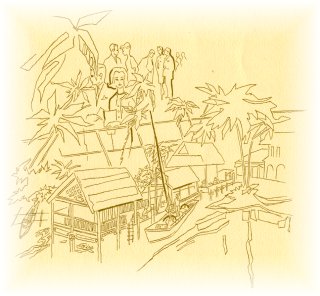 ENTERTAINMENT ON THE grand scale is usually mounted in historic proportions -- and that the Ford pavilion has. But the International Gardens exhibit in the Rotunda area is a unique exception. This delightful Lilliputian world is proportioned on a scale of one-half inch to the foot, and required the combined artistry of twenty craftsmen working twenty-eight thousand hours to create the exquisitely detailed reproductions of the twelve countries represented. In the process they laid half a million "bricks," attached three hundred thousand shingles, and spread thousands of square feet of simulated grass. ENTERTAINMENT ON THE grand scale is usually mounted in historic proportions -- and that the Ford pavilion has. But the International Gardens exhibit in the Rotunda area is a unique exception. This delightful Lilliputian world is proportioned on a scale of one-half inch to the foot, and required the combined artistry of twenty craftsmen working twenty-eight thousand hours to create the exquisitely detailed reproductions of the twelve countries represented. In the process they laid half a million "bricks," attached three hundred thousand shingles, and spread thousands of square feet of simulated grass.
- They also fashioned enough miniature fences to enclose a city block, more than three hundred and fifty thousand branches and trees, and hundreds upon hundreds of grapes, apples, flowers and assorted fruits -- not to mention the world's smallest wine bottle (it holds a single drop), the three pinhead-size skylark's eggs for the nest atop the Danish windmill, and the smaller than pin-size chopsticks used to dish out rice from a bowl smaller than a child's thimble.
|
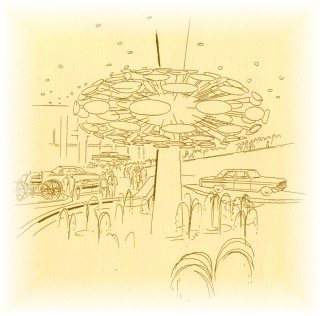 REFLECTING THE DOMINANT theme of the Fair . . . "man's achievements in an expanding universe" . . . is the Ford Pavilion's Theme Center which comprises a replica of Henry Ford's original quadricycle, the Theme Column and the Mural Wall. Although all are elements of a unified design, each has its own distinctive story to tell. The Mural Wall, one hundred and forty-five feet long and twenty-three feet high, depicts in ninety-six sculptured panels man's intellectual and creative progress through the ages -- from early writing and arithmetic, on through his developments in science, engineering, agriculture, architecture, power, the arts, and finally to recent advances of the space age. REFLECTING THE DOMINANT theme of the Fair . . . "man's achievements in an expanding universe" . . . is the Ford Pavilion's Theme Center which comprises a replica of Henry Ford's original quadricycle, the Theme Column and the Mural Wall. Although all are elements of a unified design, each has its own distinctive story to tell. The Mural Wall, one hundred and forty-five feet long and twenty-three feet high, depicts in ninety-six sculptured panels man's intellectual and creative progress through the ages -- from early writing and arithmetic, on through his developments in science, engineering, agriculture, architecture, power, the arts, and finally to recent advances of the space age.
- Symbolic of the Company's diverse activities,the rotating Theme Column and its projecting elliptical planes tell the story of the expanding world of Ford through graphic representations of today's broad range of scientific and technological principles, the numerous products that evolve from them, and the trademarks of the Corporate divisions that produce and market these products.
- Lastly is Henry Ford's hand-made quadricycle of 1896. It was the beginning of a universal industrial revolution in itself, and therefore little need be said of it -- except, perhaps, to note the exact replica of the original runs as dependably as its predecessor.
|
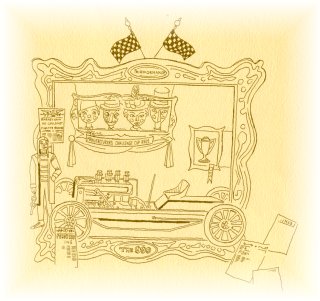 ON THE MOVING upramp the mood becomes lighter as the sprightly tune "PDSQ" -- Performance, Dependability, Style, Quality -- is heard and the first of four life-sized dioramas comes into view. This is "Performance" in the shape of Henry Ford's famous "Old 999" racing car and its equally famous driver, Barney Oldfield, who, according to Mr. Ford, "didn't know what fear was." Neither, apparently, did Mr. Ford who drove the "999" to a world's speed record of 92 m.p.h. over the ice of Lake St. Clair, Michigan, in 1904. ON THE MOVING upramp the mood becomes lighter as the sprightly tune "PDSQ" -- Performance, Dependability, Style, Quality -- is heard and the first of four life-sized dioramas comes into view. This is "Performance" in the shape of Henry Ford's famous "Old 999" racing car and its equally famous driver, Barney Oldfield, who, according to Mr. Ford, "didn't know what fear was." Neither, apparently, did Mr. Ford who drove the "999" to a world's speed record of 92 m.p.h. over the ice of Lake St. Clair, Michigan, in 1904.
- "Dependability" comes next and tells the story of a certain Dr. Phineas, the first M.D. who recognized a good thing when he saw it by trading in his horse and buggy for a Ford motor car. Incidentally, all details of the four dioramas are authentically exact, based upon information contained in the Ford Archives.
- "Style," next, captures the glamour of the times circa 1908 when for the first time the automobile influenced fashion and the linen duster and shorter skirt became de rigueur.
-
- "Quality," forth and last, is a legacy established in the old Highland Park assembly plant that still benefits owners of Ford-built cars today. Then, as now, careful inspection and thorough testing are basic principles of quality.
-
-
|
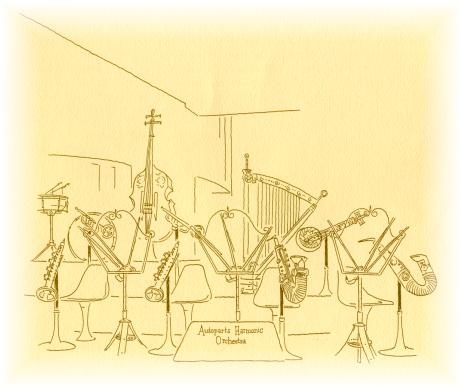 AFTER ENTERTAINING sojourns with the "Model T Diorama," nostalgic photo-murals, the "Decades of Progress," "Ford Today," and the lyrical "Musical Assembly Line," guests are serenaded by the Parts Harmonic Orchestra -- the likes of which they are unlikely to see or hear again. It's immediately apparent there are no musicians, yet the twelve instruments bob and weave as they play. Not so apparent is that all instruments are made from actual Ford automobile parts. Brake cables stretched between a drive shaft and part of a Galaxie frame become a harp; trumpets are fashioned from sections of an axle. A xylophone is created from rear spring leaves, and a banjo is shaped from a differential housing. AFTER ENTERTAINING sojourns with the "Model T Diorama," nostalgic photo-murals, the "Decades of Progress," "Ford Today," and the lyrical "Musical Assembly Line," guests are serenaded by the Parts Harmonic Orchestra -- the likes of which they are unlikely to see or hear again. It's immediately apparent there are no musicians, yet the twelve instruments bob and weave as they play. Not so apparent is that all instruments are made from actual Ford automobile parts. Brake cables stretched between a drive shaft and part of a Galaxie frame become a harp; trumpets are fashioned from sections of an axle. A xylophone is created from rear spring leaves, and a banjo is shaped from a differential housing.
- Incidentally, guests may also note the absence of an orchestra leader. The beat of the music is kept by electric windshield wipers which move in unison on each music rack.
-
|
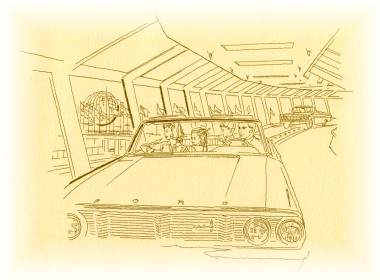 THE FIRST IMPRESSION on the embarkation platform of the Magic Skyway promises fantasy and high adventure, for although the seventy-foot platform is obviously moving, guests appear to be standing still in relation to the Ford and Lincoln-Mercury convertibles gliding in to pick them up for their exciting journey. The explanation is quite simple and not a little bit ingenious: boarding passengers and cars are moving at exactly the same rate of speed, thus assuring maximum ease getting in and out and a substantial reduction in waiting time. THE FIRST IMPRESSION on the embarkation platform of the Magic Skyway promises fantasy and high adventure, for although the seventy-foot platform is obviously moving, guests appear to be standing still in relation to the Ford and Lincoln-Mercury convertibles gliding in to pick them up for their exciting journey. The explanation is quite simple and not a little bit ingenious: boarding passengers and cars are moving at exactly the same rate of speed, thus assuring maximum ease getting in and out and a substantial reduction in waiting time.
- This is typical of the comfort and convenience built into the entire Magic Skyway ride. No effort is required of the passengers, even the person in the driver's seat, for the engineless cars are powered and guided by an electronically controlled mechanical system operated from a central control panel. Even the narration describing highlights of the ride is piped into the radio of each car, and should guests be visitors from French, German or Spanish speaking lands, a touch of a button brings the narration to them in their native language.
- Thus with nothing to do but sit back and relax, passengers may concentrate on enjoying the new adventure of the Magic Skyway that awaits them.
-
-
-
|
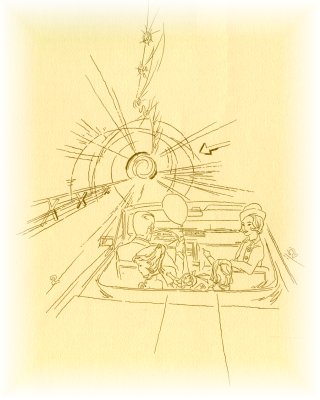 WHEN WALT DISNEY and his staff were planning and creating the entertainment for the Ford Pavilion, he remarked that it was his desire "to provide guests an entirely original experience, something no one has ever seen or done before." WHEN WALT DISNEY and his staff were planning and creating the entertainment for the Ford Pavilion, he remarked that it was his desire "to provide guests an entirely original experience, something no one has ever seen or done before."
- "It could never happen in real life," he admitted, "but we can achieve the illusion by creating an adventure so realistic that visitors will feel they have lived through a wonderful, once-in-a-lifetime experience."
- Traveling through the first "time tunnel" on the Magic Skyway is an appropriate example of his expression. The illusion is that passengers are being projected though space and time at tremendous speeds to some unknown and unseen destination.
- Those who would prefer to preserve their illusion may choose to stop reading at this point. Those who don't may be interested to know that the sensation of spaceship speed was achieved by flashing stroboscopic lights moving rapidly from the opposing direction and triggered by timed circuits and heightened by stereophonic sound effects. Illusion, yes, but also the essence of exciting entertainment.
-
-
-
|
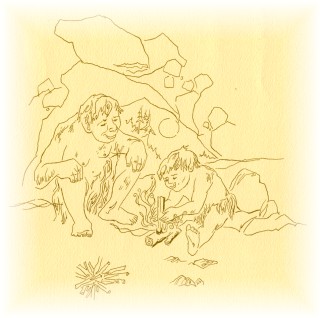 GUESTS MAY LONG remember the moment they burst forth from the "time tunnel" onto scenes of primeval splendor, enormous, animated beasts, volcanic eruptions, and then to the emergence of the caveman and other animated and realistic scenes of his conquests, struggles, discoveries and inventions. GUESTS MAY LONG remember the moment they burst forth from the "time tunnel" onto scenes of primeval splendor, enormous, animated beasts, volcanic eruptions, and then to the emergence of the caveman and other animated and realistic scenes of his conquests, struggles, discoveries and inventions.
- This is the adventure that Walt Disney referred to as "so realistic, visitors will feel they have lived through a wonderful, once-in-a-lifetime experience."
- Bringing the prehistoric world to "life" was achieved by Mr. Disney and his WED Enterprises staff by developing a remarkable technique called "Audio-Animatronics" -- animation powered by sound and controlled by electronics. Movements and sounds of the cavemen and animals are programmed onto magnetic tape. As the tape sends signals into a caveman's body, for example, each sound impulse triggers an air valve, shooting highly compressed air through plastic tubes connected to an intricate system of springs and levers that act like muscles, thereby controlling actual movements.
- One final touch of realism. The chemically processed "skin" of the cavemen has the touch of human skin, "perspires" as a human and even "bruises!"
-
|
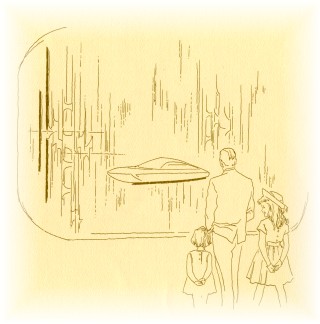 THE MOOD OF the future is continued in the Styling display, for here the world of tomorrow is being created today. This, too, is a projection in time, and the forms are necessarily abstract, for such advanced styling concepts must anticipate inevitable engineering innovations. Will the vehicle ride on a cushion of air like the experimental Ford Levacar? Will it also fly? If so, what kind of propulsion will it use? Suppose it is amphibious, what kind of stying and design would it require? Within this abstract dimensional environment, stylists must be able to conceive and create in order to lead -- in order to bring to reality the cars of the future. THE MOOD OF the future is continued in the Styling display, for here the world of tomorrow is being created today. This, too, is a projection in time, and the forms are necessarily abstract, for such advanced styling concepts must anticipate inevitable engineering innovations. Will the vehicle ride on a cushion of air like the experimental Ford Levacar? Will it also fly? If so, what kind of propulsion will it use? Suppose it is amphibious, what kind of stying and design would it require? Within this abstract dimensional environment, stylists must be able to conceive and create in order to lead -- in order to bring to reality the cars of the future.
- GUESTS AT THE Adventures in Science display may be surprised -- perhaps even a little amazed -- to discover the breadth and depth of the Company's activities in the exotic worlds of advanced research and development.
- For the purpose of better understanding by those uninitiated in the sciences, Ford's continuing programs in space age technology are suggested rather than demonstrated by a series of displays that make use of dramatic lighting effects, shapes and sounds.
|
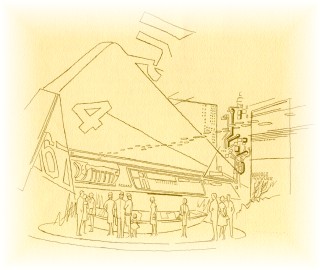
A case in point is the display of complex computers which the Company actually designs and manufactures through its Philco subsidiary. Here, a myriad of symbols and numbers literally flash through air as a taped narration explains the numerous uses to which computers are put in researching, engineering and producing better, more efficient products.
- Similar displays tell the story of research into advanced new power sources, electronic systems and materials, while space research displays emphasize Philco's significant contributions to the Apollo and Gemini manned space flight to the moon, important command and control systems, satellites and numerous other space age programs.
-
|
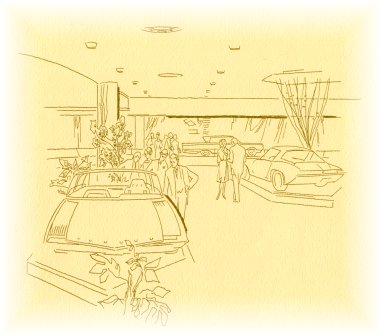 IN THE QUIET elegance of the Product Salon, handsomely sleek Ford-Built motor cars of 1964 are positioned tastefully throughout the spacious area, while others revolve like mannequins on turntable islands, thus enabling guests to study them from every angle. IN THE QUIET elegance of the Product Salon, handsomely sleek Ford-Built motor cars of 1964 are positioned tastefully throughout the spacious area, while others revolve like mannequins on turntable islands, thus enabling guests to study them from every angle.
- Extending along an entire wall of the Salon is the Product Parade where guests may watch a stream of Company cars, trucks and tractors moving against a background of scenery that dramatically changes from peaceful countryside to bustling city and from day to night.
- For racing buffs, there are also total performance-tested Ford competition cars to be seen from time to time -- the low-slung, Ford-powered Lotus, popular hero at Indianapolis, the Ford-powered Cobra, winningest sports car in years, and the burly Ford-built stock cars that have made a habit of providing only rear views to the competition.
- Guests also have the opportunity to examine an imposing trio of idea cars" -- the Aurora, Cougar II, and the Allegro. For the moment, at least, they are cars of tomorrow, but tomorrow seems never very far away.
|
|